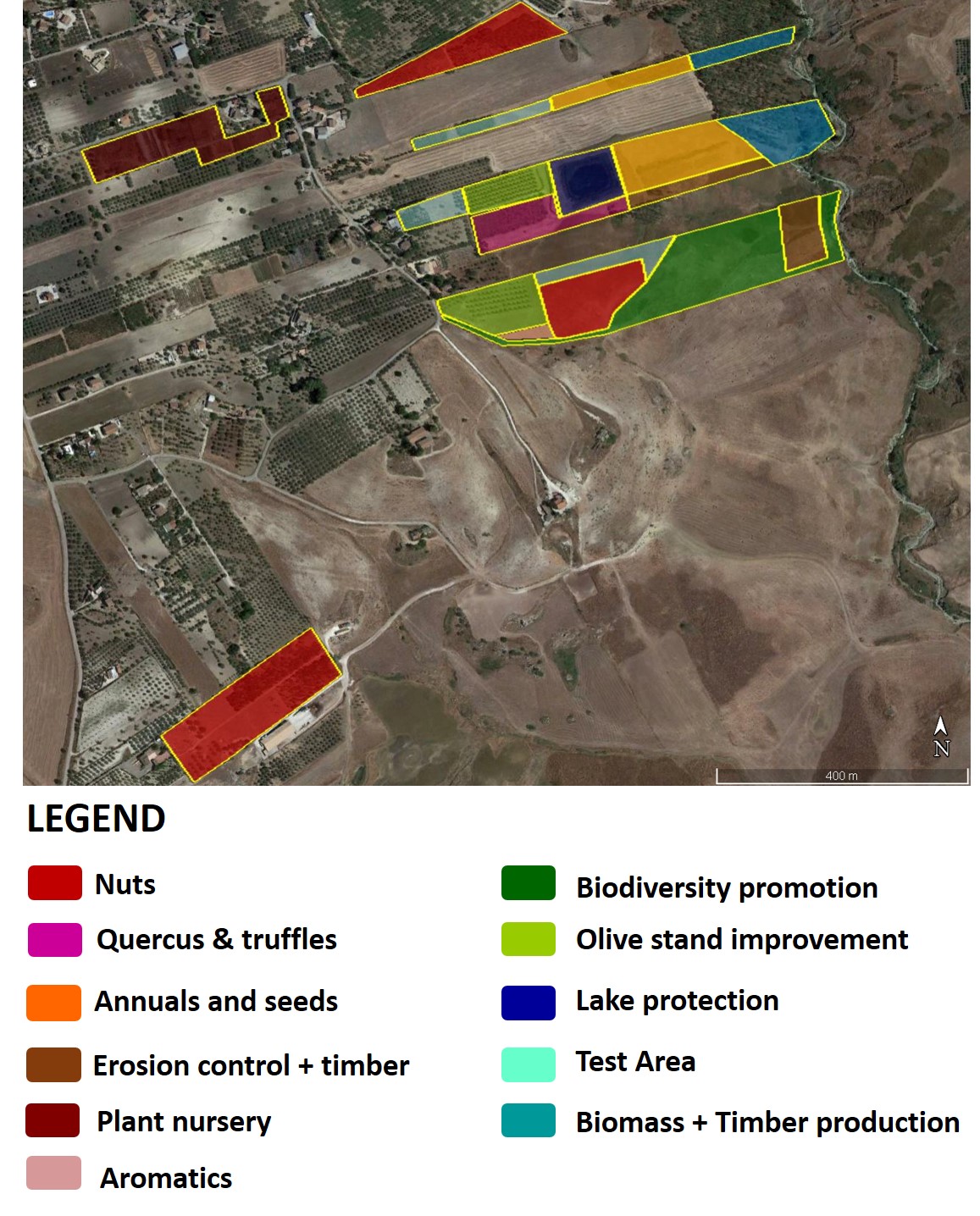|
|
L2-L11 REAM - Ambiente&Territorio (IT) |
||||
|
|
|||||
|
FUNCTIONS APPLIED TO THE LAND |
|||||
|
ECONOMIC |
|||||
|
Aromatics [1] |
Planting aromatics (e.g. oregano, English lavender, Spanish lavender, saffron crocus, Lemon balm) to control erosion and increase food for pollinators. |
||||
|
Annuals and seeds [2] |
Production of seeds of indigenous selected species (e.g. Lygeum spartum, Ampelodesmos mauritanicus) that are then used for naturalistic engineering purposes, such as the construction of natural fences. |
||||
|
Biomass and Timber for naturalistic engineering [3 and 19] |
Two sites localized in the steepest areas of property. Eucalyptus and Tamarix planted for poles production as erosion control products and fences. A sustainable harvesting plan is adopted to create a rotation system. |
||||
|
Bee keeping [11] |
The hives have been installed. Native species such as black bees have been used to avoid competition with wild bees. Honey will be sold. |
||||
|
Quercus & Truffle [12] |
Mycorrhizae inoculated downy oaks for production of black and whitish truffles and for improving plant health. |
||||
|
Plant Nursery [14]
|
Own production of plants for naturalistic engineering purposes. As part of project, mycorrhizae inoculation of planting materials. |
||||
|
Nuts [15] |
Almond, walnut and pistachio groves. Specifically, Pistacia vera and other local varieties will be grafted on Pistacia terebintus that is more resistant to drought. |
||||
|
Olive stand improvement [16] |
No tillage. Green manure and grass cutting are conducted. | ||||
|
Compost production [100] |
Compost produced mainly using pruning and wood wastes for own use and selling | ||||
|
ECOSERVICES |
|||||
|
Test Area [32] |
Testing: i) various species used for engineering purposed (Hydroseeding); ii) local walnut varieties ; iii) horticulture crops which wastes will be used for the production of compost. | ||||
|
ENVIRONMENTAL |
|||||
|
Erosion control + timber [37 and 19] |
Areas under high erosion risks, were sown with sulla clover (Hedysarum coronarium) to improve soil carbon and nitrogen content and contrast erosion. In addition, several tree species such as Tamarix capable to fix soil and avoid soil erosion, are planted in swales to reduce surface run-off. |
||||
|
Insect and bird shelter [40] |
Bird and bat houses, as well as insect hotels installed to increase biodiversity of beneficial organisms like pollinators and natural enemies of pest. In addition, nidification poles for storks were created to attract them. |
||||
|
Rivers & Open water [42] |
Planting aquatic plants for filtration. To avoid erosion shrub (e.g. mastic tree and wild rose) trees (e.g. poplar and willow) have been planted on banks and around ponds. A small deck was built to access the lake. Additionally, a floating islands for amphibian has been create with materials taken from the area. |
||||
| Biodiversity promoting plants [46] |
2-meter-wide natural fence around most of the others functions to support biodiversity and in the meantime to act as fire break lines (e.g. Opuntia). |
||||
|
SOCIAL |
|||||
| Create employment
[47] |
See honey and oil production | ||||
|
Provide social services |
Working with schools. | ||||
| MEASURES APPLIED TO THE LAND | |||||
| N. | Name | Comments | |||
| 1 | Seed collecting & native species |
Sicilian forestry protocol establish seedlings must be produced with seeds collected locally. |
|||
| 3 | Existing vegetation |
Transplantation of small trees, using dead and live eucalyptus trunks to build stork nests and poles, chipping other woody vegetation to improve organic matter. |
|||
| 4 | Mycorrhizae & plants |
Mycorrhizae used to produce mushrooms and inoculated onto plants to make them more resilient to droughts, diseases and increases root surface. This in cooperation with university of Palermo. |
|||
| 7 | Swales |
Swales will be created on slopes to reduce surface run-off and accommodate trees. |
|||
| 9 | Half-moons |
They will be made on slopes planting. |
|||
| 11 | Conservation Tillage |
Just superficial tillage with light disc tiller for annuals and seeds and firebreak. On the other sites just cutting the vegetation with a shredder. |
|||
| 14 | Organic fertilizer |
Own compost (made with pruning and wood wastes) is used. |
|||
| 23 | Planting in mixes |
Plant in cocoons and controls were planted following this AM. |
|||
| 26 | Plant support & Water aids study |
Cocoons and jute discs were used in the first trial. The plan is to use mulching (leaves), biodegradable jute discs, local chips and probably rocks. |
|||
| 27 | Watering/Drip irrigation |
Drip irrigation in some parts and irrigation with water tanks on tractor where needed. |
|||
| 29 | Plant assist |
Biodegradable juta disc, shelter made with canna (Arundo donax), organic mulch (leaves), chips. |
|||
| 31 | Grafting trees |
Trees grafted in both nursery and in the field (pistachia vera grafted onto pistachia terebintus, or almond grafted onto pear). |
|||
| 32 | Diseased trees |
First an analysis of potential death causes. If diseases, seedlings/plants are removed then buried, crushed or burned. |
|||
| 33 | Weed control |
No chemicals. Mulching and cutting. |
|||
| 34 | IPM Plague control |
By now no plagues, but if needed IPM will be used. |
|||
| 35 | Prunings |
Pruning will be used as mulching, compost or chipped. |
|||
| 42 | Biofuels |
When available will be used. |
|||
|
43 |
Planting on ridges? |
Yes, planting in furrows is foreseen.
|
|||
|
Numbers of functions and measures correspond to the list reported in the DAM methodology, defining the operative DAM plan http://www.desert-adapt.it/index.php/en/case-studies/dam-methodology |
|||||
| FIELD IMPLEMENTATION OF THE DAM PLAN | |||||
|
Testing plant growth aid techniques to support seedlings establishment and growth [Adaptation Measures: plant support & water aid 26 - plant protectors 28 - plant assist 29] In A&T plant supports that improve the seedling survival rates in the first years after planting under harsh environmental conditions, were tested, as part of the project objectives and in collaboration with the LIFE project the GreenLink. The techniques are supposed also to reduce the need to intervene with emergency irrigation in the hottest periods, thus reducing the logistic complexity of managing extended planting and reforestation activities. The plant water aid “Cocoon” (https://www.youtube.com/watch?v=sll6IO65vPg) was tested and compared with biodegradable jute discs. Pictures from 1 to 5 show the cocoon set up. The biodegradable material (i.e. cellulose) of the cocoon is filled with water, which is slowly release through seepage. The cocoon is then capped (Pict. 2), with the seedling protected with a cylindrical shelter (Pict. 3-5), and covered with soil. In the same areas others plant growth aids using nature based solutions were tested using biodegradable jute discs (Populus nigra seedling, Pict. 6) to reduce weed competition and evaporation, while a shelter made with reeds (Arundo donax) was created to accommodate the seedling protecting it from wind, excess light and reducing water loss by evapotranspiration (Pict 7-9). The two techniques were tested on replicates (Pict. 10). Periodically, the team of University of Palermo monitored the seedling growth and the cocoon performance. The activity is ongoing (Pict. 11-13). |
|||||
|
|
|||||
|
Bee Keeping [Economic Function: Bee Keeping 11] Landowner installed beehives to support pollination and biodiversity in the farm while also producing a marketable product, the honey. This is an example of win-win options for sustainable land management, which have positive effects as both economic and ecological functions and improve the land natural capital. They also contribute to differentiate the economic income of the land increasing business resilience to extreme events induced by market or natural causes. Pictures show the beehives installation and management. |
|||||
|
|
|||||
|
Functions to support biodiversity [Environmental Functions: Insect and bird shelters 40; Rivers & open water 42] Landowner selected several functions to support biodiversity at all levels. A&T created nidification poles for storks including an additional pole with fake models of birds to stimulate their attraction towards the area. Nidification poles were created using mainly local materials and placed close to the lake. Pictures from 1 to 9 show the stork poles installations. During the following months the manager of A&T added also plant materials close to the pole site to help the bids to nidificate by providing them suitable materials which was pruned from the close by plants and trees (Pict. 10-11). A floating island for amphibian was created and put in the artificial lake with materials taken from the farm and organized by Francesco Matraxia into this nice floating platform with vegetation. Pictures from 12 to 18 show its set up. Biodiversity monitoring is ongoing (gull egg Pict. 19, monitoring Pict. 20). |
|||||
|
|
|||||
|
Seeds production and biodiversity support [Econimic function: Annuals and seeds 2; Adaptation Measure: Seed collecting & native species 1] Sicilian forestry protocol establish seedlings must be produced with seeds collected locally. In A&T indigenous selected species (e.g. Lygeum spartum, Ampelodesmos mauritanicus) are used to produce seeds for naturalistic engineering purposes (Pict 1-4), such as the construction of natural fences. Pictures from 5 to 8 show different phases of the threshing of French honeysuckle (Hedysarum coronarium). Planting annual plants support biodiversity to, with special reference to pollinator (Pict. 9). |
|||||
|
|
|||||
|
Seedling and plant mycorrhization [Economic function: Plant nursery 14; Adaptation Measure: Mycorrhizae & plants 4] The farm produces in their own plant nursery plants for naturalistic engineering purposes. As part of project, A&T prepared and tested mycorrhizae inoculation of local wild plant species, starting from seeds collected in Sicily in the study areas as dictated by Sicilian forestry protocol (Pict. 1-6). Mycorrhizae were then inoculated onto plants to make them more resilient to droughts, diseases and to increase their root surface. The work was organized in cooperation with university of Palermo, prof. Paola Quatrini, partner of the project. Other seedling, both shrubs and tree, were inoculated just before the planting with arbuscular mycorrhizal fungi (Pict. 7-15). Furthermore, such mycorrizae mix was added to soil (Pict.16) as well as green compost produced mainly using pruning and wood wastes (Pict. 17). Additionally, downy oaks have been inoculated with mycorrhizae for truffles production and for improving their health. |
|||||
|
|
|||||







